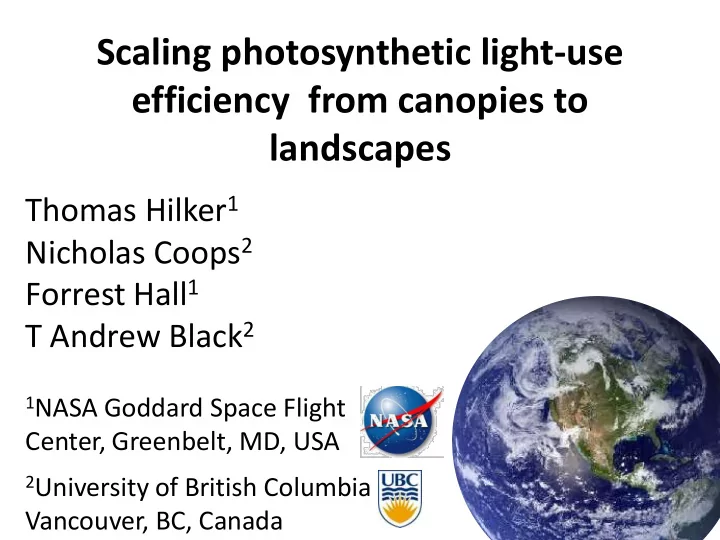

Scaling photosynthetic light-use efficiency from canopies to landscapes Thomas Hilker 1 Nicholas Coops 2 Forrest Hall 1 T Andrew Black 2 1 NASA Goddard Space Flight Center, Greenbelt, MD, USA 2 University of British Columbia Vancouver, BC, Canada
Remote sensing of Photosynthesis Monteith (1972,1977): GPP f PAR PAR Light-use efficiency term ε
Photosynthetic Energy Pathways photons 1. chlorophyll fluorescence 2. photochemical quenching e - e - e - e - e - e - e - e - energy level e - e - e - e - e - H + H + H + H + H + H + antenna chlorophyll 3. non-photochemical quenching (xanthophyll cycle) A Cell’s Light Harvesting Complex (Size 0.2 μ m) 3 Hilker et al., Science of the Total Environment (2008)
Associated changes in reflectance 570 531 PRI 0.4 570 531 reflectance 531nm 0.3 0.2 500 550 600 wavelength (nm) 4
Effects of Structure on Remote Sensing of Photosynthesis I. Physical effects moving sun moving observer Figure: D. Culvenor 5 Hilker et al., Journal of Geophysical Research(2008)
Effects of Structure on Remote Sensing of Photosynthesis II. Physiological effects shaded sunlit shaded ε = high ε = low 6 Hall et al. Remote Sensing of Environment (2008)
Amspec Automated Multi-Angular Spectroradiometer Hilker et al., Computers and Electronics in Agriculture (2007) 7 Hilker et al. Instrumentation Science and Technology (2010)
Amspec data 8 Hilker et al. Instrumentation Science and Technology (2010)
Combining Structure and Function: Inferring Photosynthetic Efficiency sunlit shaded ε = high ε = low sunlit 9 Hilker et al., Remote Sensing of Environment (2008)
RS of Photosynthetic Efficiency 0 sunlit shaded r 2 =0.87 -0.02 r 2 =0.91 PRI -0.04 -0.06 -0.08 0 1 2 3 -1 Light-use efficiency ( ɛ gCMJ -1 ) Light-use efficiency ( ɛ gCMJ -1 ) gC MJ not considering structure considering structure 10 Hilker et al., Remote Sensing of Environment (2008,2009)
Calculating shadow fractions ( α s ) SOA DF-49 11 Hilker et al., Remote Sensing of Environment (2010)
Calculating shadow fractions ( α s ) 12 Hilker et al., Tree Physiology (2008)
Remote sensing of ε across sites 1 st derivative of PRI (wrt α s ) vs. ε 13 Hilker et al., Remote Sensing of Environment (2010)
Scaling Up: CHRIS/Proba Satellite Figure: UK Space Agency 14 Hall, Hilker et al., Remote Sensing of Environment (in press)
Scaling Up 15 Hilker et al., Journal of Geophysical Research (in press)
Obtaining PRI and Shadow fractions from CHRIS/Proba Corresponding Shadow fractions Reflectance for from spectral endmembers given overpass 16 Hilker et al., Journal of Geophysical Research (in press)
Structural Differences of Test Sites 17 Hilker et al., Journal of Geophysical Research (in press)
Satellite-derived Photosynthesis 18 Hilker et al., Journal of Geophysical Research (in press)
Satellite-derived Photosynthesis 19 Hilker et al., Journal of Geophysical Research (in press)
Conclusions 1. Consecration of structure is essential for robust stand level sensing of function 2. Structure can be obtained from multi-angle spectral observations -1 can be used to infer instantaneous 3. Δ PRI Δα s ε across different biomes 4. This relationship can be upscaled to space using an adequate sensor 20
PhotosynSat: Photosynthesis from Space 21
Thank you!! For your attention! Questions? Thomas Hilker, PhD NASA Goddard Space Flight Center Biospheric Sciences Branch Code 614.4 Greenbelt, MD 20771, USA ☏ : +1 301.286.8597 : +1 301.614.6695 Mobile: +1 301.326.3743 Email: thomas.hilker@nasa.gov 22
Integrating Remote Sensing and Carbon Models Satellite observations of GEP 23
Carbo Europe: Long-term monitoring of ecosystem change 24
Eddy covariance/AMSPEC footprint Hilker et al., Journal of Geophysical Research(2008) Flux footprint model: Chen et al. 2008
AMSPEC system Range & Bandwidth: 400-1200 nm @ 10nm Sampling rate: ~ 5 sec sunrise to sunset Full Rotation: 15 minutes 26
Sensitivity to shadow fractions Stand level ε =const NDRI PRI 27 Hall et al., 2008, RSE
Conclusions for spaceborne PRI mission A satellite design comparable to MODIS can only work ε = ε 1 when correcting directional ε = ε 2 effects from the ground (for ε = ε 3 instance using an AMSPEC) 28
Conclusions for spaceborne PRI mission Along-track sensor observes PRI from multiple angles for ε = ε 1 =const constant ε Instantaneous ε can be inferred from Δ PRI Δα s-1 29
Concept validation: CHRIS Proba Operator : ESA (European Space Agency) Date of Launch : 22 October 2001 Orbit Height : 615 km Orbit Type : Sun-synchronous elliptical polar Repeat Cycle : approx. 7 days Resolution : 18 m (CHRIS) Swath Width : 14 km (CHRIS) 30
Concept validation: CHRIS Proba up to 5 acquisitions per overpass Cut-on Cut-off Central Band Wavelength Wavelength Wavelength Bandwidth 1 419.4 422 420.7 2.6 2 437 447.4 442 10.4 3 484.1 495.6 489.8 11.6 12 overpasses (@4-5 angles) for 4 523.8 535.3 529.5 11.4 5 544.4 557.2 550.7 12.9 6 564 574.6 569.3 10.6 the DF-49 site during 2009 7 623.6 637.6 630.5 14 8 652.4 668.1 660.1 15.7 9 668.1 679 673.5 10.9 10 690.4 702.2 696.2 11.8 11 702.2 708.3 705.2 6.1 (Mode 3) 12 708.3 714.5 711.4 6.2 13 733.8 747.3 740.4 13.5 14 747.3 754.2 750.7 6.9 15 768.4 790.9 779.5 22.5 16 857 884.3 870.5 27.4 17 884.3 903.1 893.6 18.8 18 903.1 912.9 908 9.7 31
For Assistance and Support with Amspec: • Zoran Nesic, UBC LFS • Dominic Lessard, UBC, LFS • Rick Ketler, UBC, LFS • Andrew Hum, UBC, LFS For Sharing Data and Concepts: • Mike Wulder, NRCAN, CFS 32 • Alexei Lyapustin, NASA GSFC •
Recommend
More recommend